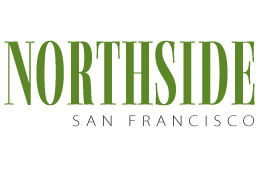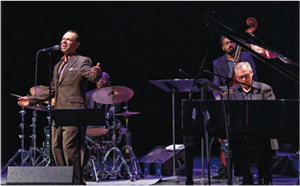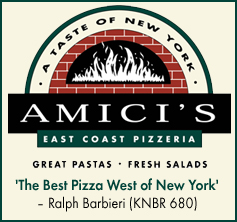 |

|
|||||||
|
Jazz in San Francisco’s glory days: From the fifties to now  Kurt Elling, 2010 Grammy award-winner, performs with the Count Basie Orchestra on May 30 at Davis Symphony Hall as part of SFJAZZ’s spring season. The season continues through mid-June, followed by free summer concerts in Levi’s Plaza. Tickets and information available at 866-920-5299, www.sfjazz.org.
photo: Daniel Sheehan These days the historic Fillmore Jazz Preservation District has been designed to set this right. Yoshi’s, the pioneering jazz club in Oakland’s Jack London Square, opened in the Fillmore and is thriving. There are a few other clubs there as well as the Jazz Heritage Center, a fine museum and art gallery devoted to promoting the art form. In the early fifties, the Blackhawk (on the edge of the Tenderloin) was the City’s premiere jazz club, but it closed in 1963 and the jazz scene moved on. North Beach, with its reputation as a louche entertainment enclave, emerged as the San Francisco jazz epicenter and reigned as such in the fifties, sixties and even into the seventies. In those days there were several top North Beach jazz clubs along the one block of Broadway between Columbus and Montgomery: • The Jazz Workshop, where Miles Davis, Cannonball Adderley, Gerry Mulligan, Stan Getz, Horace Silver, John Coltrane, and Dizzy Gillespie held forth; • Basin Street West, where one could be in the royal presence of Duke Ellington and his orchestra; • Sugar Hill headlined big name blues stars like John Lee Hooker, Big Mama Willie Mae Thornton and T-Bone Walker; and • El Matador with top performers such as Charlie Byrd, Erroll Garner, the Modern Jazz Quartet, George Shearing, and Oscar Peterson. In 1957 at the Cellar (576 Green Street), Kenneth Rexroth and Lawrence Ferlinghetti were mixing poetry and jazz, a noble but flawed experiment. Frequently the poetry was very good and so was the jazz. Together, it didn’t add up. It was a not a match made in heaven. Later in what could have been a mismatch, Bill Graham’s Fillmore Auditorium presented not only the top rock ’n’ roll acts but many jazz artists too. Chet Helms at the Avalon Ballroom did the same. One night at the Avalon, Charles Lloyd and his superb jazz quartet were on the same bill as Janis Joplin with Big Brother and the Holding Company. No one thought this pairing was the least bit strange. Among the crowds almost any evening during the North Beach jazz heyday, one could find trench-coated Ralph J. Gleason, the San Francisco Chronicle’s perceptive music critic and social commentator; the academic Phil Elwood from the Examiner; and visiting writers from Downbeat and big Eastern newspapers making the rounds. Jimmy Lyons, founder of the Monterey Jazz Festival, lived on Telegraph Hill. His apartment was always open to visiting jazz stars, who later in the evening made their way down the hill to North Beach and hung out in Enrico’s, Vanessi’s and the hungry i. Lyons was a nighttime jazz D.J. on KFRC and liked to play the music of Dave Brubeck, Cal Tjader, and even the bopper Dizzy Gillespie. Those were exciting times. In 1965, mercurial bassist Charles Mingus played the Jazz Workshop. Mingus was in a mood. Between highly original pieces like “Fables of Faubus” and “Goodbye Pork Pie Hat,” he picked up his leather bullwhip and cracked it intermittently out over the heads of the worshipful but astonished audience. One evening Dizzy Gillespie was appearing at the Workshop, and between sets he jaywalked across Broadway to Sugar Hill where Carmen McRae was singing. Dizzy stepped up on the small stage, and to Carmen’s surprise he accompanied her obbligato on his strange up-tilted trumpet as she shaped her version of “I Left My Heart in San Francisco.” Duke Ellington held court in his underwear and a silk robe in a dressing room in the basement of Basin Street West. Between air kisses for the ladies gathered there, he worked on his score for the Concert of Sacred Music he would later present at Grace Cathedral. But by the seventies, the jazz balloon in North Beach was deflating. Then in 1972, faster than a speeding bullet, a young man named Todd Barkan took over Keystone Corner at 750 Vallejo. Since 1969, the dingy North Beach club had featured rock bands like the Grateful Dead, New Riders of the Purple Sage and Creedence Clearwater Revival. Mike Bloomfield, Elvin Bishop and Boz Scaggs dropped in for sessions. Under Barkan, Keystone Corner became a jazz club. McCoy Tyner, Bill Evans, Rasheed Roland Kirk, Sonny Rollins, Art Blakey, and even Miles Davis appeared there. But Barkan – perhaps not the swiftest with the pocket calculator – was on a collision course with economic reality. In 1983 the club was foundering. There were several fundraisers including one by Bill Graham at the Fillmore. It netted $1,500. Barkan was finished and moved to New York. The North Beach jazz twilight years were upon us. The Jazz Workshop, Basin Street West, Sugar Hill, El Matador, and Keystone Corner had disappeared. However, Jazz at Pearl’s on Columbus opened in 1990, showed much promise, and demonstrated considerable staying power. But it finally went belly up in 2008 – the times they were a changin’. The glory days of jazz in North Beach seem to be a thing of the past, and not likely, it would appear, to return. But then, never say never. These days there is still jazz in North Beach: Joey and Eddie’s, the Washington Square Bar and Grill, and a few other restaurants and clubs feature jazz, much of it exemplary. Blues is strong in North Beach at the Saloon and a few other sites. SFJAZZ has become one of the foremost events of its kind in the world, and the Fillmore Jazz Preservation District is off life support and getting frisky. But one still misses those glory days when Duke, Miles, Dizzy, Coltrane, Getz, and other giants were among us. Ernest Beyl is a jazz devotee of long standing. He remembers hearing Gene Krupa
|
||||||||
 |
||||||||
|
||||||||
|
||||||||
|
||||||||

|
||||||||

|
||||||||


